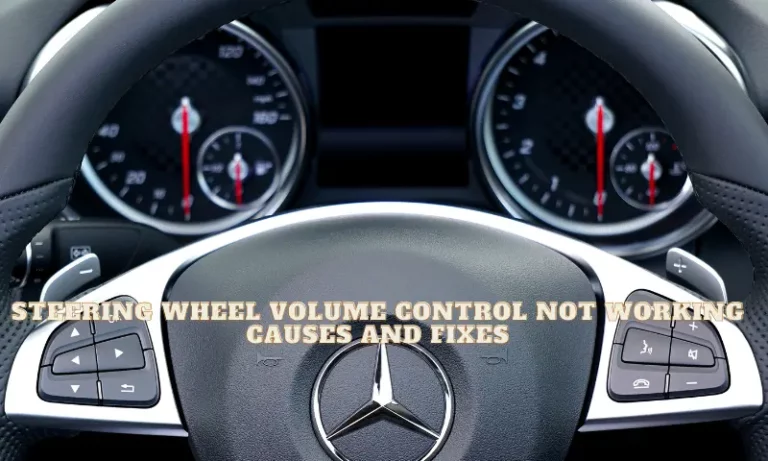You are driving your car and decide to reduce the volume of your stereo just to find out the steering wheel volume control is inoperable.
That can be a big mood spoiler. Especially with the fact that this electrical malfunction may be affecting other close by components like the internal range and airbag connections.
Not to worry, we will discuss the issue to get your steering wheel volume control working properly.
This article will examine the causes, symptoms and fixes of the steering wheel volume control problem.
Why Has My Steering Wheel Volume Control Stopped working?
Two main theories may be responsible for the malfunction of the steering wheel volume control.
First, let’s look at what is within the steering wheel. Many drivers limit their steering to just a directional tool.
It includes internal remoting, airbag, audio controls and rotational feature.
Now that we understand what is inside your steering let’s look at the causes.
There are two major reported causes of the malfunction, although not limited to these two.
- A faulty clockspring
- And misalignment of the control system
These two causes shall form the basis of our discussion.
What is the clockspring?
A clockspring is a portable spring that stores energy on a rotating axis. It consists of a flat multicore cable shaped spirally, called a clockspring.
It is located within the steering wheel just underneath the air pad of the steering wheel.
Without the clockspring, many of the non-stationary controllers will be unable to perform well.
It is because as you turn your car’s steering wheel, these controllers rely on the clockspring to expand and retract to accommodate the non-stationary circuits.
In addition, the steering wheel volume control and other controls send signals to the control modules through the clockspring.
It is also in charge of discharging the airbag in an accident.
Causes of a damaged clockspring
Wear and tear from continuous expansion and retraction is responsible for most clockspring damage in a car. It is an inevitable faith of the clockspring as it is constantly stressed over time.
Another cause of a faulty clockspring is steering linkage damage. A damaged linkage causes over-rotation of the steering wheel, which will strain the spring.
Also, wiring or burnt connections may cause the clockspring to be damaged. This broken wire causes an interruption in electrical signals, thereby disrupting many components.
Furthermore, water entering the steering system can cause corrosion damaging the clockspring.
How to fix a damaged Clockspring
You can fix your vehicle steering wheel by following the steps listed below:
- Unplug your car’s battery and wait at least 10 minutes for the power to drain completely.
- Spot the two-hole clip behind each side of the steering wheel.
- Using an SST tool, insert into the hole and gently apply pressure. It should allow you to remove the airbag pads from the steering. Disconnect the airbag plug and place it on a safe surface
- Also, disconnect the plug of the clockspring.
- You should notice the nuts that fasten the clockspring. Ensure you remove all.
- Using a marker or tape, mark the position of the steering wheel.
- Find the click bar and unlock it. You should hear a clicking sound. If you do, you can go ahead and remove the clockspring.
- Replace the clockspring with a new one.
- Follow the steps backward and install the new clockspring.
Misalignment of the control system
The second primary cause of the steering wheel volume control not working is a misalignment of the control system.
It is possible that during a repair or an accident, the control system and buttons are misaligned, causing the keys to malfunction or not work.
In such a case, you must manually lose the steering wheel and properly align the control system.
How do you fix steering wheel volume control?
Fixing the Steering Wheel Volume Control will range from simple techniques to highly complex methods depending on the cause.
1. Replace the damaged clockspring:
This method has been discussed in detail above. If you suspect the Clockspring of your car is damaged, it’s best to replace it with a new one.
The clockspring controls many important components in your car, including the activation of the airbag. So, ensure you purchase a quality clockspring from your vehicle dealership.
2. Check and replace the blown fuse
Many electrical components in your car are connected and regulated by a fuse. Using the vehicle electrical diagram, trace the fuse designated to the steering wheel control system.
Check the condition of the fuse and replace it with a new one if it is short-circuited.
3. Replace the car’s switchboard
If you suspect your car’s switchboard is damaged, then it becomes necessary for you to replace it with a new one. Ensure to buy a compatible switchboard with the brand and model of your car.
Also, seek professional help if you face difficulties buying or installing the switchboard in your vehicle.
4. Clean Control Buttons
Dirt and debris may be responsible for your volume control not working. In this case, thoroughly clean and remove debris stuck within the buttons.
Frequently Asked Questions (FAQ)
How much does it cost to replace a clockspring?
A clockspring part cost around $100 to $150 from an authorized dealer. It will cost you an additional $200 to as much as $500 to hire a professional mechanic to help you fix it.
Final Thought!
While many issues might be responsible for the steering wheel volume control to stop working, our experience shows that faulty clockspring and a misaligned control system are the major cause.
We recommend that our readers check for these symptoms before proceeding with others.
Furthermore, we recommend seeing a mechanic if you still face challenges in fixing the volume control. Thank you for reading through!




